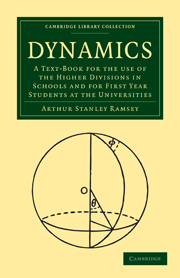 Dynamics
Dynamics This book is intended primarily for the use of students in the higher divisions in schools, particularly for those who intend to take an Honours Course of Mathematics at a University, and also for University students preparing for a first Honours Examination. It is based upon courses of lectures given during many years to first-year students preparing for the Mathematical Tripos, and it is assumed that the majority of readers will already have acquired some knowledge of elementary dynamics. Although the book contains chapters on Orbits and the dynamics of Rigid Bodies, none the less it may claim to be a text-book on Elementary Dynamics, for there is probably no branch of elementary Mathematics the content of which has expanded so greatly in the last twenty years.
One of the changes that accompanied the reform of the Mathematical Tripos was the removal of the restriction that Elementary Mechanics meant Mechanics without the Calculus. This restriction set well-defined and narrow bounds to the subject and the new regulations which gave teachers and students freedom to use any analytical methods in their work have been far reaching in their effect. Though the schedule in Dynamics for Part I of the new Tripos has remained unaltered, successive Examiners have added considerably to the interpretation of its contents. To give one instance only—the phrase ‘motion under gravity’ is now understood to mean ‘in a resisting medium’—and it would be easy to give other examples of the elasticity of interpretation to which the schedule lends itself.
To save this book to your Kindle, first ensure [email protected] is added to your Approved Personal Document E-mail List under your Personal Document Settings on the Manage Your Content and Devices page of your Amazon account. Then enter the ‘name’ part of your Kindle email address below. Find out more about saving to your Kindle.
Note you can select to save to either the @free.kindle.com or @kindle.com variations. ‘@free.kindle.com’ emails are free but can only be saved to your device when it is connected to wi-fi. ‘@kindle.com’ emails can be delivered even when you are not connected to wi-fi, but note that service fees apply.
Find out more about the Kindle Personal Document Service.
To save content items to your account, please confirm that you agree to abide by our usage policies. If this is the first time you use this feature, you will be asked to authorise Cambridge Core to connect with your account. Find out more about saving content to Dropbox.
To save content items to your account, please confirm that you agree to abide by our usage policies. If this is the first time you use this feature, you will be asked to authorise Cambridge Core to connect with your account. Find out more about saving content to Google Drive.